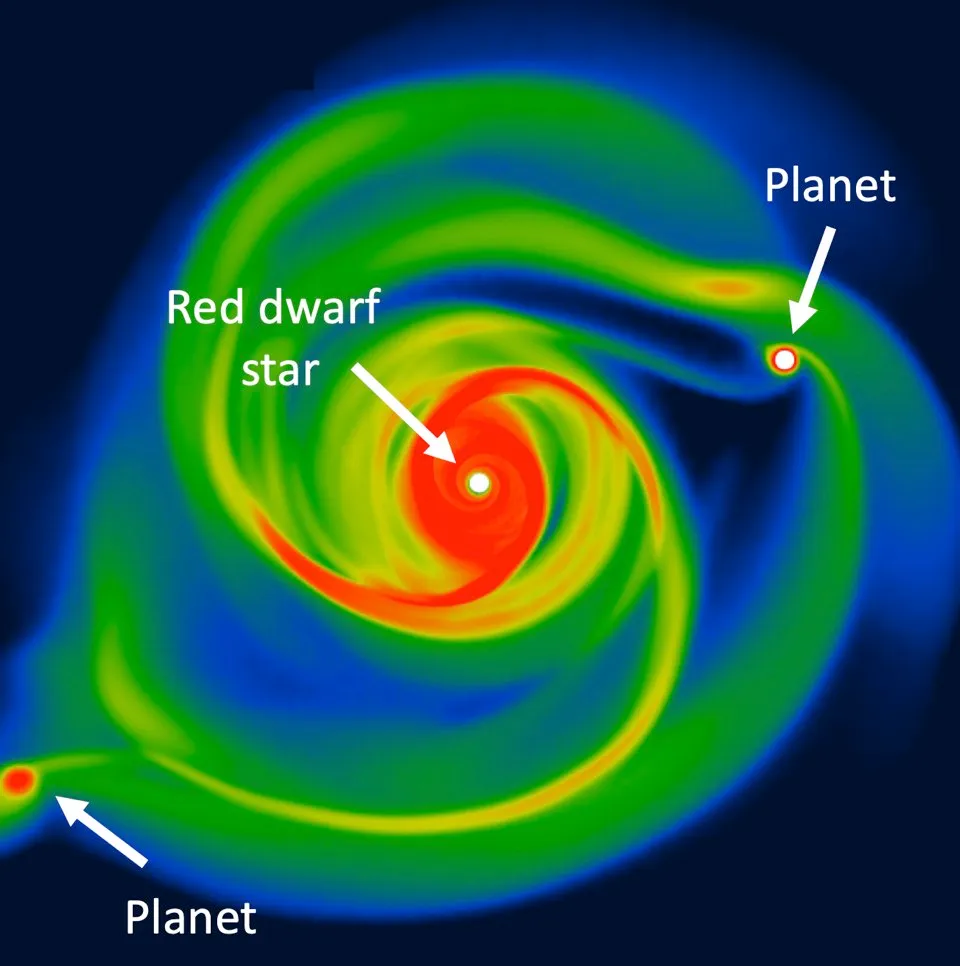Giant planets could form around small stars much faster than previously thought, astronomers say.
Red dwarfs – the most common type of stars in our Galaxy – are small stars, 10 per cent to 50 per cent the size of the Sun.
Despite this, they are found to host giant planets up to 10 times bigger than the largest planet in the Solar System – Jupiter.
The formation mechanism of these big planets remains a mystery.
Giant planets around stars are thought to have formed by the gradual build-up of dust particles to progressively bigger bodies.
However, red dwarfs are tiny when compared to the Sun, and they do not seem to have enough material around them to form such big planets.
But research from the University of Central Lancashire (UCLan) published in the Astronomy and Astrophysics Journal suggests giant planets could form around small stars much faster than previously thought.
Read more about planet formation:
- Levitating particles could reveal how planets form
- If all the asteroids in the asteroid belt had coalesced to form a planet, what size would it have been?
Dr Anthony Mercer and Dr Dimitris Stamatellos used the UK Distributed Research using Advanced Computing (DiRAC) supercomputing facility to simulate the evolution of protoplanetary discs around red dwarf stars.
Protoplanetary discs are rotating structures of dense gas and dust found around all newly-born stars.
Researchers found that if these young discs are big enough, they can break up and form gas giant planets.
This theory predicts the formation of giant planets happening within a few thousand years, a timescale which is extremely fast in astrophysical terms.
Dr Mercer, who led the research, said: “The fact that planets may be able to form on such short timescale around tiny stars is incredibly exciting.
“Our work shows that planet formation is particularly robust: other worlds can form even around small stars in a variety of ways, and therefore planets may be more diverse than we previously thought.”

According to the study, these planets are extremely hot when they form, with core temperatures reaching thousands of degrees.
Planets that are so hot would be relatively easy to observe when they are still young.
Without an internal energy source they become fainter with time, and the window of opportunity to directly observe them is very small.
Nevertheless, they can still be indirectly observed by their effect on their host star.
Reader Q&A: What is at the centre of a gas giant planet like Jupiter?
Asked by: Liam Farmer, Nottingham
This is one of the key questions astronomers hope to resolve with data from NASA’s Juno mission, currently orbiting Jupiter. Jupiter’s atmosphere is made up of around 90 per cent hydrogen and 10 per cent helium, so computer models suggest its core may be made from metallic hydrogen, a bizarre form of the element thought to exist at extreme pressures.
Read more:
Co-author of the research Dr Stamatellos, astrophysicist in UCLan’s Jeremiah Horrocks Institute, added: “This was the first time that we were able not only to see planets forming in computer simulations but also to determine their initial properties with great detail.
“It was fascinating to find that these planets are of the ‘fast and furious’ kind – they form quickly and they are unexpectedly hot.”
Future observations of planets around very young red dwarf stars will test the predictions of this new theory.
The research was funded by a PhD studentship from the Science and Technologies Facilities Council (STFC).
